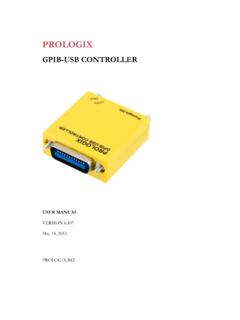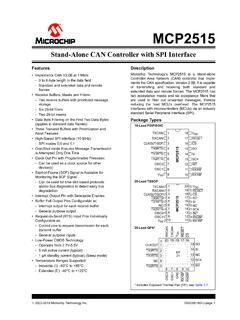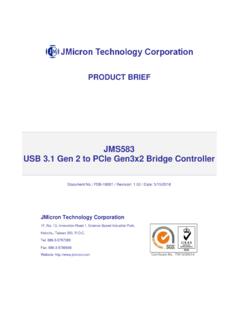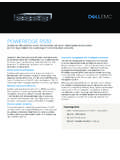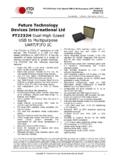Transcription of 2/3-Port EtherCAT® Slave Controller with Integrated ...
1 2015 Microchip Technology 1 Highlights 2/3-Port EtherCAT Slave Controller with 3 Fieldbus Memory Management Units (FMMUs) and 4 SyncManagers Interfaces to most 8/16-bit embedded controllers and 32-bit embedded controllers with an 8/16-bit bus Integrated Ethernet PHYs with HP Auto-MDIX Wake on LAN (WoL) support Low power mode allows systems to enter sleep mode until addressed by the Master Cable diagnostic support to variable voltage I/O Integrated regulator for single operation Low pin count and small body size packageTarget Applications Motor Motion Control Process/Factory Automation Communication Modules, interface Cards Sensors Hydraulic & Pneumatic Valve Systems Operator InterfacesKey Benefits Integrated high-performance 100 Mbps Ethernet transceivers- Compliant with IEEE (Fast Ethernet)- 100 BASE-FX support via external fiber transceiver- Loop-back modes- Automatic polarity detection and correction- HP Auto-MDIX EtherCAT Slave Controller - Supports 3 FMMUs- Supports 4 SyncManagers- Distributed clock support allows synchronization with other EtherCAT devices- 4K bytes of DPRAM 8/16-Bit host Bus interface - Indexed register or multiplexed bus- Allows local host to enter sleep mode until addressed by EtherCAT Master- SPI / Quad SPI support Digital I/O Mode for optimized system cost 3rd port for flexible network configurations Comprehensive power management features- 3 power-down levels- Wake on link status change (energy detect)- Magic packet wakeup, Wake on LAN (WoL)
2 , wake on broadcast, wake on perfect DA- Wakeup indicator event signal Power and I/O- Integrated power-on reset circuit- Latch-up performance exceeds 150mA per EIA/JESD78, Class II- JEDEC Class 3A ESD performance- Single power supply ( Integrated regulator) Additional Features- Multifunction GPIOs- Ability to use low cost 25 MHz crystal for reduced BOM Packaging- Pb-free RoHS compliant 64-pin QFN or 64-pin TQFP-EP Available in commercial, industrial, and extended industrial* temp. ranges*Extended temp. (105 C) is supported only in the 64-QFN with anexternal voltage regulator (internal regulator must be disabled) (typ) Ethernet EtherCAT Slave Controller with Integrated Ethernet PHYsLAN9252DS00001909A-page 2 2015 Microchip Technology OUR VALUED CUSTOMERSIt is our intention to provide our valued customers with the best documentation possible to ensure successful use of your Microchipproducts.
3 To this end, we will continue to improve our publications to better suit your needs. Our publications will be refined andenhanced as new volumes and updates are introduced. If you have any questions or comments regarding this publication, please contact the Marketing Communications Department viaE-mail at We welcome your Current DocumentationTo obtain the most up-to-date version of this documentation, please register at our Worldwide Web site at: can determine the version of a data sheet by examining its literature number found on the bottom outside corner of any page. The last character of the literature number is the version number, ( , DS30000000A is version A of document DS30000000).ErrataAn errata sheet, describing minor operational differences from the data sheet and recommended workarounds, may exist for cur-rent devices. As device/documentation issues become known to us, we will publish an errata sheet.
4 The errata will specify therevision of silicon and revision of document to which it determine if an errata sheet exists for a particular device, please check with one of the following: Microchip s Worldwide Web site; Your local Microchip sales office (see last page)When contacting a sales office, please specify which device, revision of silicon and data sheet (include -literature number) you Notification SystemRegister on our web site at to receive the most current information on all of our products. 2015 Microchip Technology Preface .. General Description .. Pin Descriptions and Configuration .. Power Connections .. Register Map .. Clocks, Resets, and Power Management .. Configuration Straps .. System Interrupts .. host Bus interface .. SPI/SQI Slave .. Ethernet PHYs .. EtherCAT .. EEPROM interface .. Chip Mode Configuration.
5 General Purpose Timer & Free-Running Clock .. Miscellaneous .. JTAG .. Operational Characteristics .. Package Outlines .. Revision History .. 325 LAN9252DS00001909A-page 4 2015 Microchip Technology TermsTABLE 1-1:GENERAL TERMSTermDescription10 BASE-T10 Mbps Ethernet, IEEE compliant100 BASE-TX100 Mbps Fast Ethernet, compliantADCA nalog-to-Digital ConverterALRA ddress Logic ResolutionANAuto-NegotiationBLWB aseline WanderBMBuffer Manager - Part of the switch fabricBPDUB ridge Protocol Data Unit - Messages which carry the Spanning Tree Protocol informa-tionByte8 bitsCSMA/CDCarrier Sense Multiple Access/Collision DetectCSRC ontrol and Status RegistersCTRC ounterDADestination AddressDWORD32 bitsEPCEEPROM ControllerFCSF rame Check Sequence - The extra checksum characters added to the end of an Ethernet frame, used for error detection and In First Out bufferFSMF inite State MachineGPIOG eneral Purpose I/OHostExternal system (Includes processor, application software, etc.)
6 IGMPI nternet Group Management ProtocolInboundRefers to data input to the device from the hostLevel-Triggered Sticky BitThis type of status bit is set whenever the condition that it represents is asserted. The bit remains set until the condition is no longer true and the status bit is cleared by writ-ing a Significant BitLSBL east Significant ByteLVDSLow Voltage Differential SignalingMDIM edium Dependent InterfaceMDIXM edia Independent interface with CrossoverMIIM edia Independent InterfaceMIIMM edia Independent interface ManagementMILMAC interface LayerMLDM ulticast Listening DiscoveryMLT-3 Multi-Level Transmission Encoding (3-Levels). A tri-level encoding method where a change in the logic level represents a code bit 1 and the logic output remaining at the same level represents a code bit 0 .msbMost Significant BitMSBMost Significant Byte 2015 Microchip Technology 5 LAN9252 NRZINon Return to Zero Inverted.
7 This encoding method inverts the signal for a 1 and leaves the signal unchanged for a 0 N/ANot ApplicableNCNo ConnectOUIO rganizationally Unique IdentifierOutbound Refers to data output from the device to the hostPISOP arallel In Serial OutPLLP hase Locked LoopPTPP recision Time ProtocolRESERVEDR efers to a reserved bit field or address. Unless otherwise noted, reserved bits must always be zero for write operations. Unless otherwise noted, values are not guaran-teed when reading reserved bits. Unless otherwise noted, do not read or write to reserved ClockSASource AddressSFDS tart of Frame Delimiter - The 8-bit value indicating the end of the preamble of an Ethernet In Parallel OutSMIS erial Management InterfaceSQES ignal Quality Error (also known as heartbeat )SSDS tart of Stream DelimiterUDPUser Datagram Protocol - A connectionless protocol run on top of IP networksUUIDU niversally Unique IDentifierWORD16 bitsTABLE 1-1:GENERAL TERMS (CONTINUED)TermDescriptionLAN9252DS00001 909A-page 6 2015 Microchip Technology TypesTABLE 1-2.
8 BUFFER TYPESB uffer TypeDescriptionISSchmitt-triggered inputVISV ariable voltage Schmitt-triggered inputVO8 Variable voltage output with 8 mA sink and 8 mA sourceVOD8 Variable voltage open-drain output with 8 mA sinkVO12 Variable voltage output with 12 mA sink and 12 mA sourceVOD12 Variable voltage open-drain output with 12 mA sinkVOS12 Variable voltage open-source output with 12 mA sourceVO16 Variable voltage output with 16 mA sink and 16 mA sourcePU50 A (typical) internal pull-up. Unless otherwise noted in the pin description, internal pull-ups are always pull-up resistors prevent unconnected inputs from floating. Do not rely on internal resistors to drive signals external to the device. When connected to a load that must be pulled high, an external resistor must be A (typical) internal pull-down. Unless otherwise noted in the pin description, internal pull-downs are always pull-down resistors prevent unconnected inputs from floating.
9 Do not rely on internal resistors to drive signals external to the device. When connected to a load that must be pulled low, an external resistor must be inputAIOA nalog bidirectionalICLKC rystal oscillator input pinOCLKC rystal oscillator output pinILVPECLLow voltage PECL input pinOLVPECLLow voltage PECL output pinPPower pin 2015 Microchip Technology NomenclatureTABLE 1-3:REGISTER NOMENCLATURER egister Bit Type NotationRegister Bit DescriptionRRead: A register or bit with this attribute can be : A register or bit with this attribute can be only: Read only. Writes have no only: If a register or bit is write-only, reads will return unspecified One to Clear: Writing a one clears the value. Writing a zero has no effectWACW rite Anything to Clear: Writing anything clears the to Clear: Contents is cleared after the read. Writes have no Low: Clear on read of High: Clear on read of : Contents are self-cleared after the being set.
10 Writes of zero have no effect. Contents can be : Contents are self-setting after being cleared. Writes of one have no effect. Contents can be Only, Latch High: Bits with this attribute will stay high until the bit is read. After it is read, the bit will either remain high if the high condition remains, or will go low if the high condition has been removed. If the bit has not been read, the bit will remain high regardless of a change to the high condition. This mode is used in some Ethernet PHY Affected by Software Reset. The state of NASR bits do not change on assertion of a software Field: Reserved fields must be written with zeros to ensure future compati-bility. The value of reserved bits is not guaranteed on a 8 2015 Microchip Technology DESCRIPTIONThe LAN9252 is a 2/3-Port EtherCAT Slave Controller with dual Integrated Ethernet PHYs which each contain a full-duplex 100 BASE-TX transceiver and support 100 Mbps (100 BASE-TX) operation.










